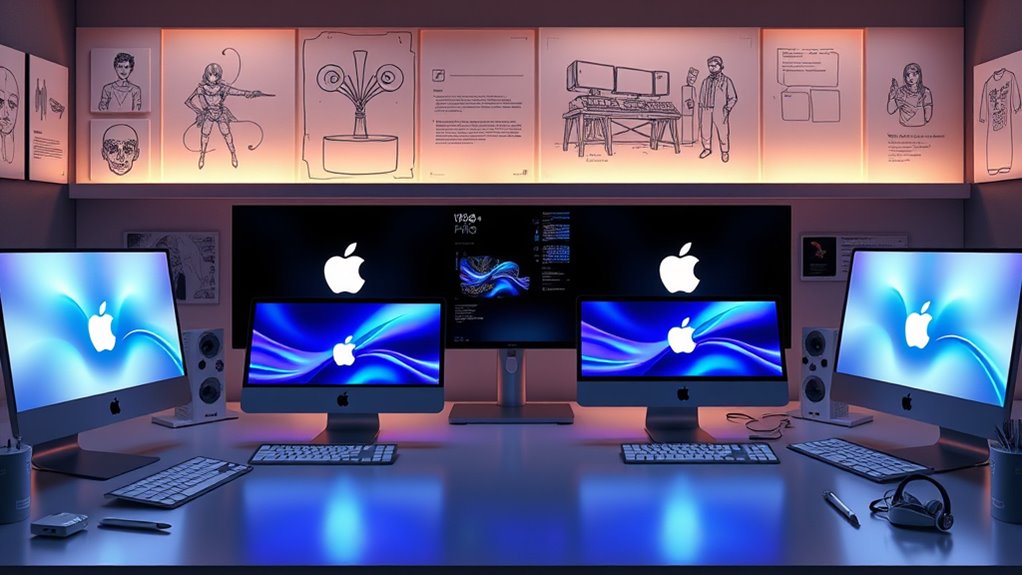If you’re after the top Mac Studios with 128GB+ unified memory in 2025, my choices include models equipped with M4 Max or M4 Pro chips for maximum power. These machines excel in handling large datasets, complex workflows, and demanding creative tasks. They strike a balance between performance and future-proofing, making them ideal for professionals. Keep exploring, as I’ll share detailed insights to help you find the perfect fit.
Key Takeaways
- Mac Studio with M4 Max offers the highest 128GB+ unified memory, ideal for intensive creative workflows like 3D rendering and video editing.
- The M4 Pro-based Mac Studio balances high memory capacity with robust processing power for demanding professional applications.
- Consider external connectivity options and workspace requirements to support future expansion and high-performance peripherals.
- Compatibility with professional software such as Adobe Creative Cloud and Final Cut Pro ensures optimal performance with large memory pools.
- High-memory Mac Studios tend to have higher power consumption, so energy efficiency and cooling considerations are essential for setup.
Apple 2024 Mac mini Desktop Computer with M4 Chip
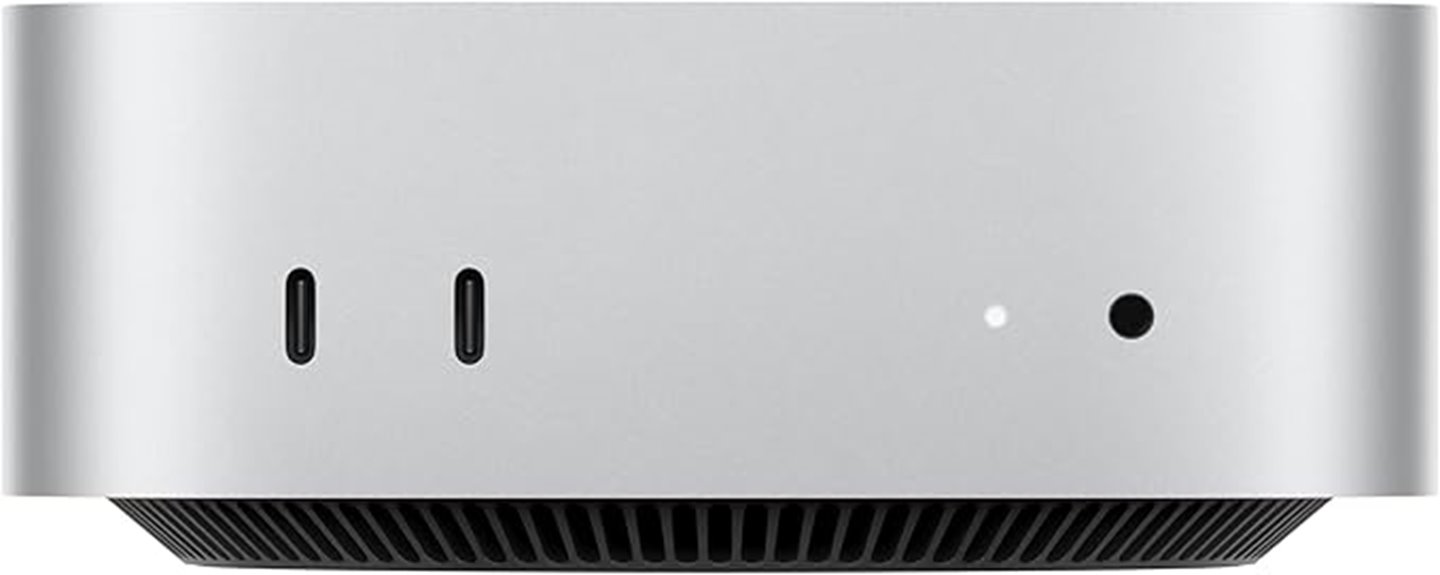
If you’re looking for a compact yet powerful desktop that fits seamlessly into small spaces, the Apple 2024 Mac mini with the M4 chip is an excellent choice. Its five-by-five-inch design packs serious performance, with a 10-core CPU, 10-core GPU, and up to 32GB of unified memory. Weighing just 1.5 pounds, it’s incredibly portable and runs quietly, producing minimal heat. It supports multiple high-resolution displays via Thunderbolt and HDMI, making it perfect for multitasking. Built with sturdy quality and seamless Apple ecosystem integration, this Mac mini delivers impressive speed and efficiency in a tiny footprint—ideal for creative professionals and space-conscious users.
Best For: creative professionals, small-space users, and those seeking a powerful, compact desktop with seamless Apple ecosystem integration.
Pros:
- Compact, space-efficient design fits easily into small workspaces
- Powerful performance with M4 chip, supporting demanding tasks like video editing and music production
- Quiet operation with minimal heat, ideal for noise-sensitive environments
Cons:
- Non-upgradable RAM and storage limit future expandability
- Limited ports compared to traditional desktops, may require additional hubs for peripherals
- Higher cost relative to other small-form-factor computers with similar specs
Apple 2024 Mac mini Desktop Computer with M4 Chip
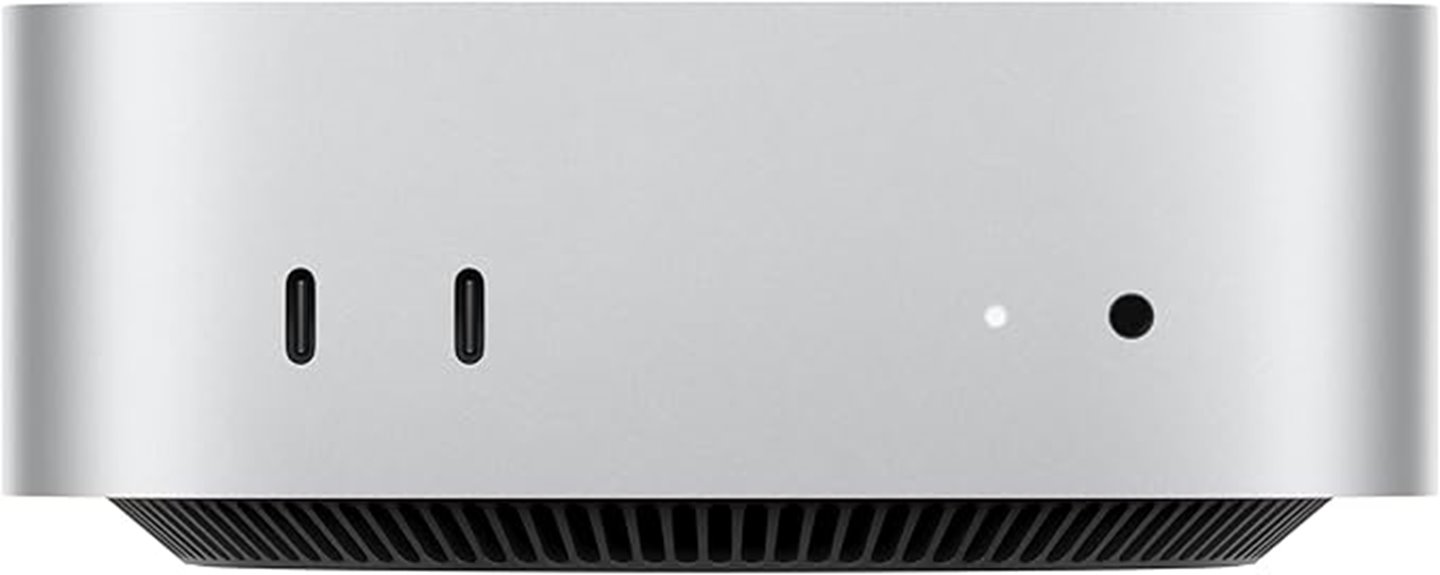
The Apple 2024 Mac mini with M4 chip stands out as an ideal choice for professionals and power users who need a compact yet highly capable desktop. Its five-by-five-inch size fits neatly next to any monitor, making it perfect for space-constrained setups. Despite its small footprint, it delivers impressive performance with a 10-core CPU, 10-core GPU, and 16-core Neural Engine. With 16GB of unified memory (upgradable to 24GB or 32GB) and fast SSD storage, it handles multitasking, media editing, and data transfer effortlessly. Its quiet operation and efficient cooling make it a reliable, space-saving powerhouse for creative workflows.
Best For: professionals and power users seeking a compact, high-performance desktop for creative work, multitasking, and data-intensive tasks.
Pros:
- Compact size fits easily next to monitors and in space-constrained setups
- Powerful M4 chip with high-core counts provides excellent performance for multitasking and media editing
- Quiet operation and efficient cooling make it ideal for extended use without noise or overheating
Cons:
- Non-upgradable RAM and storage limit future expandability
- Requires external cables and drives for maximum performance and storage expansion
- Limited ports on the front may necessitate additional hubs or adapters for certain peripherals
Apple Mac mini Desktop Computer with M4 Pro chip

Designed for demanding users who need compact yet powerful performance, the Apple Mac mini with M4 Pro chip packs desktop-level capabilities into a small footprint. Measuring just 5×5 inches, it easily fits beside monitors or in tight spaces. Powered by the M4 Pro chip, it features a 12-core CPU and 16-core GPU, handling complex tasks effortlessly. With 24GB of unified memory and a 512GB SSD, it offers fast, responsive performance for demanding creative workflows. Connectivity options include Thunderbolt, HDMI, Gigabit Ethernet, front USB-C ports, and a headphone jack. Despite its small size, this Mac mini delivers impressive power suited for professional use.
Best For: demanding creative professionals and power users seeking a compact yet high-performance desktop with advanced Apple Silicon capabilities.
Pros:
- Compact 5×5 inch design fits easily in any workspace or next to monitors
- Powered by the robust M4 Pro chip with a 12-core CPU and 16-core GPU for demanding tasks
- Supports fast connectivity options including Thunderbolt, HDMI, Gigabit Ethernet, and USB-C
Cons:
- Limited internal storage with only 512GB SSD, which may require external drives for large files
- No dedicated graphics card options, relying solely on integrated GPU performance
- Might be overpowered for casual users who do not require high-end creative or computational power
Apple Mac mini Desktop Computer with M4 Chip (2024)
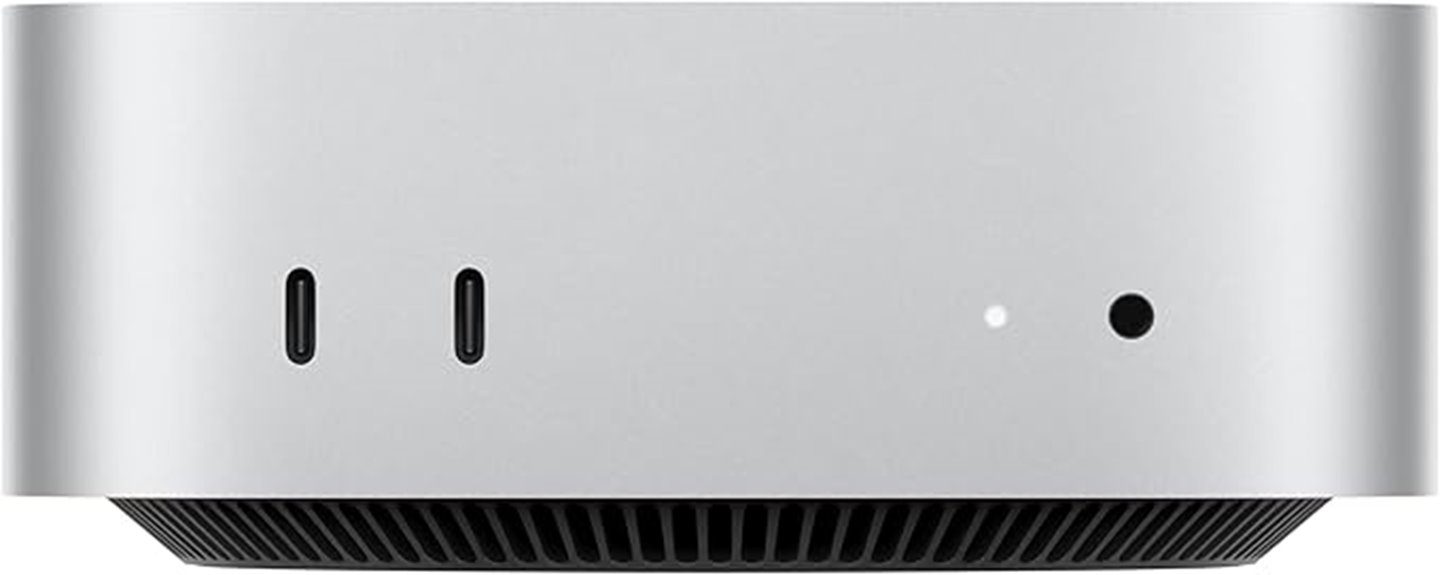
For creative professionals and power users who need a compact yet highly capable desktop, the Apple Mac mini with M4 chip (2024) is an exceptional choice. Its five-by-five-inch design makes it easy to place anywhere, and at just 1.5 pounds, it’s highly portable. Powered by the M4 chip with a 10-core CPU and GPU, plus up to 32GB of unified memory, it delivers impressive speed for multitasking, media editing, and rendering. The hardware includes multiple Thunderbolt 4 ports, HDMI, and Ethernet options, supporting up to three displays. Quiet, cool-running, and seamlessly integrated with macOS, it’s a powerful, space-efficient desktop for demanding workflows.
Best For: creative professionals, power users, and small workspace setups seeking a compact, high-performance desktop with advanced connectivity and seamless integration with macOS.
Pros:
- Compact, space-saving design that fits easily in any workspace
- Powerful M4 chip with 10-core CPU and GPU delivering impressive speed and multitasking capabilities
- Quiet operation with minimal heat and noise, ideal for focused work
Cons:
- Non-upgradable RAM and storage limits future expandability
- Limited ports on the front, requiring external hubs for additional peripherals
- Higher price point compared to some traditional mini PCs with similar specs
Factors to Consider When Choosing a Mac Studio With 128GB+ Unified Memory
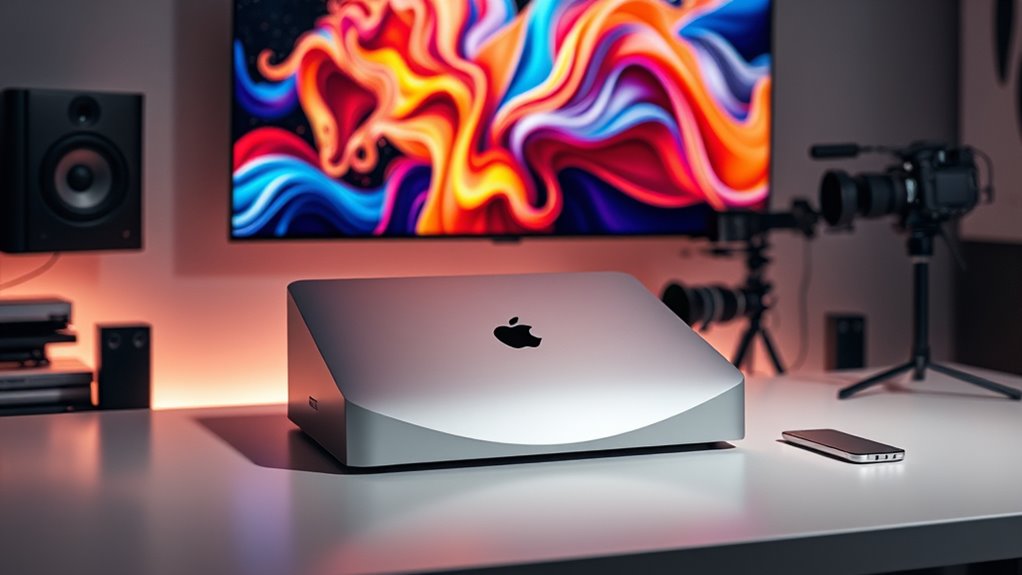
When selecting a Mac Studio with 128GB+ of unified memory, I look at my specific memory needs and how much processing power I require for my work. Budget plays a role, but I also consider software compatibility and whether the machine permits for future upgrades. Balancing these factors helps guarantee I choose a system that fits both my current and long-term demands.
Memory Capacity Needs
Choosing a Mac Studio with 128GB or more of unified memory is a smart move if you work with large datasets, complex simulations, or run multiple demanding applications at once. High memory capacity minimizes reliance on external storage and boosts performance in memory-intensive tasks like 3D rendering and professional video editing. With 128GB or more, I can run several intensive applications simultaneously without lag or slowdown, which is vital for productivity. Additionally, larger memory pools enable faster data access and transfer rates, essential for AI training and managing large databases. Investing in ample memory ensures my setup remains future-proof, accommodating evolving software demands and increasingly complex projects. This capacity provides the headroom needed to handle professional workloads smoothly and efficiently.
Processing Power Requirements
As memory capacity increases to 128GB or more, the processing power of the Mac Studio becomes even more critical to prevent bottlenecks and guarantee smooth performance. Demanding tasks like large-scale 3D rendering, complex data analysis, and professional video editing require not only ample RAM but also a robust CPU. Advanced processors such as the M4 Pro or M4 Max chips are essential, as they can handle intensive workflows efficiently. A powerful CPU minimizes processing delays, accelerates rendering times, and manages multitasking seamlessly. When selecting a Mac Studio with high memory, guarantee it pairs that with a top-tier processor. This combination guarantees that your system keeps pace with your workload, avoids slowdowns, and delivers the performance needed for professional-grade tasks.
Budget Considerations
High-memory Mac Studios come with a significant price tag, often running into several thousand dollars. When planning your budget, consider not just the cost of the machine but also additional expenses like peripherals, external storage, and software licenses. While investing in a high-memory Mac Studio makes sense for demanding professional workloads, it might be overkill for casual or light use. Promotions and discounts on top-tier models tend to be limited, so timing your purchase can be vital. It’s wise to compare the cost of these premium configurations with alternative setups or workstation options to guarantee it aligns with your financial plan. Being clear about your needs and budget will help you make a more informed choice, avoiding overspending on features you may not fully utilize.
Compatibility With Software
Since many demanding applications rely heavily on large memory pools, verifying that your software is fully compatible with a Mac Studio equipped with 128GB+ of unified memory is essential. First, confirm your macOS version supports the software you plan to use, especially high-memory-demand programs. Next, verify that your applications are optimized for Apple Silicon to maximize performance. It’s also important to ensure that the software can effectively utilize large memory pools for tasks like data processing, 3D rendering, or running virtual machines. Professional creative tools such as Adobe Creative Cloud, Final Cut Pro, and CAD applications typically benefit from extensive RAM, but double-check their specifications. Finally, review developer documentation for any known issues or recommendations related to large memory configurations to avoid potential compatibility problems.
Future Expansion Options
Are you considering how your Mac Studio with 128GB+ of unified memory can grow with your needs? The good news is that its advanced connectivity options make expansion straightforward. It offers multiple Thunderbolt ports, allowing you to add external drives, displays, or even external GPUs to boost performance. The variety of USB-C and USB-A ports means you can connect external storage, audio interfaces, or networking hardware as your workflow evolves. While internal upgrades are limited after purchase, these external ports provide flexibility for future expansion. Supporting high-speed external devices and daisy-chaining options ensures your setup can adapt to increased demands. This versatility makes a Mac Studio with 128GB+ not just powerful today but also ready for the growth of your creative projects tomorrow.
Space and Setup
Have you thought about how your workspace will support a Mac Studio with 128GB+ of unified memory? It’s essential to verify your desk has enough space for the Mac Studio itself, plus any peripherals or external displays you plan to use. Placement matters for ideal airflow and cooling, especially with high-performance setups. A cluttered or cramped environment can lead to overheating or accessibility issues. You also need to confirm that your desk can handle the weight and size of the Mac Studio, which is compact but still sturdy. Additionally, consider the proximity to power outlets and network connections to keep setup seamless and avoid excessive cable stretching. Proper planning ensures your workspace is efficient, organized, and ready to handle this powerful creative hub.
Power Consumption Impact
Choosing a Mac Studio with 128GB+ of unified memory means understanding how it will impact your power consumption. Larger memory configurations require more energy due to additional modules and circuitry, especially during intensive multitasking or data-heavy workflows. As the memory pool grows, so does the power needed to maintain it, which can lead to increased energy use overall. This rise in power draw may affect energy efficiency and could demand more cooling, especially during heavy workloads. If you’re operating in energy-conscious environments or using uninterruptible power supplies (UPS), these factors become even more important. Recognizing the relationship between memory size and power consumption helps you optimize your setup for both performance and energy management, ensuring your high-memory Mac Studio runs efficiently without unnecessary power drain.
Ecosystem Integration
Ecosystem integration is a key factor to contemplate when selecting a Mac Studio with 128GB+ of unified memory, as it guarantees smooth collaboration across your Apple devices. With seamless transfer of files, messages, and clipboard content, I can work efficiently without switching apps or losing focus. Features like Handoff and Universal Clipboard allow me to start a task on my Mac and continue on my iPhone or iPad effortlessly. AirDrop makes sharing large files quick and easy, eliminating the need for external drives. FaceTime and iMessage are integrated across devices, ensuring uninterrupted communication. Deep integration with macOS and iOS also enables automation and device management, streamlining workflows and boosting productivity. This interconnectedness makes the Mac Studio a true hub for creative professionals.
Frequently Asked Questions
How Does 128gb+ Unified Memory Improve Professional Workflows?
Having 128GB+ of unified memory dramatically boosts my workflow by enabling me to run intensive applications smoothly. I can handle large files, complex 3D renders, and multitask seamlessly without slowdowns. It minimizes delays, increases productivity, and allows me to focus on creativity rather than technical limitations. This level of memory makes my work more efficient, especially when working on demanding projects that require substantial processing power.
Are Mac Studios With High RAM Compatible With All Creative Software?
They say, “The proof is in the pudding,” and with Mac Studios boasting over 128GB of unified memory, I’ve found they’re compatible with most creative software. I’ve used high-end applications for editing, 3D rendering, and audio production without issues. While some niche programs may need updates, generally, these Macs handle demanding workflows seamlessly, making them reliable powerhouses for any professional’s toolkit.
What Are the Energy Consumption Impacts of High-Memory Mac Studios?
High-memory Mac Studios do consume more energy, but the increase is relatively modest thanks to efficient Apple silicon chips. I’ve noticed that while they require more power during intensive tasks, their power management keeps energy use balanced during everyday activities. If you’re concerned about energy efficiency, I recommend using energy-saving settings and monitoring usage, but overall, these machines offer impressive performance without markedly boosting your energy bills.
Can External GPU Setups Enhance Performance on 128gb+ Mac Studios?
Absolutely, external GPU setups can boost performance on 128GB+ Mac Studios, especially for demanding tasks like rendering or 3D modeling. They’re like turbochargers, enabling extra graphics power when needed. I’ve seen creators push their workflows further with eGPUs, cutting rendering times and enhancing visual processing. If you’re aiming for peak performance, exploring external GPU options might just be the game-changer you need to elevate your creative projects.
How Future-Proof Are Mac Studios With 128gb+ Unified Memory?
I believe Mac Studios with 128GB+ unified memory are quite future-proof, especially for creative pros. Apple’s ecosystem and hardware upgrades keep these machines relevant longer, handling demanding tasks like video editing, 3D rendering, and AI workflows with ease. While tech always evolves, I’m confident these Macs will serve well for years, offering solid performance and upgradability through software updates, making them a smart investment for the future.
Conclusion
Choosing a Mac Studio with 128GB+ unified memory is like assembling a powerful orchestra—each component must work in harmony to produce beautiful, seamless creations. Whether you opt for the M4 or M4 Pro, these machines are the maestros for any creative professional. Trust me, investing in one of these workhorses will turn your ideas into symphonies of innovation, giving you the strength and flexibility to conquer any project with confidence.
